1993 BUICK RIVIERA run flat
[x] Cancel search: run flatPage 12 of 324
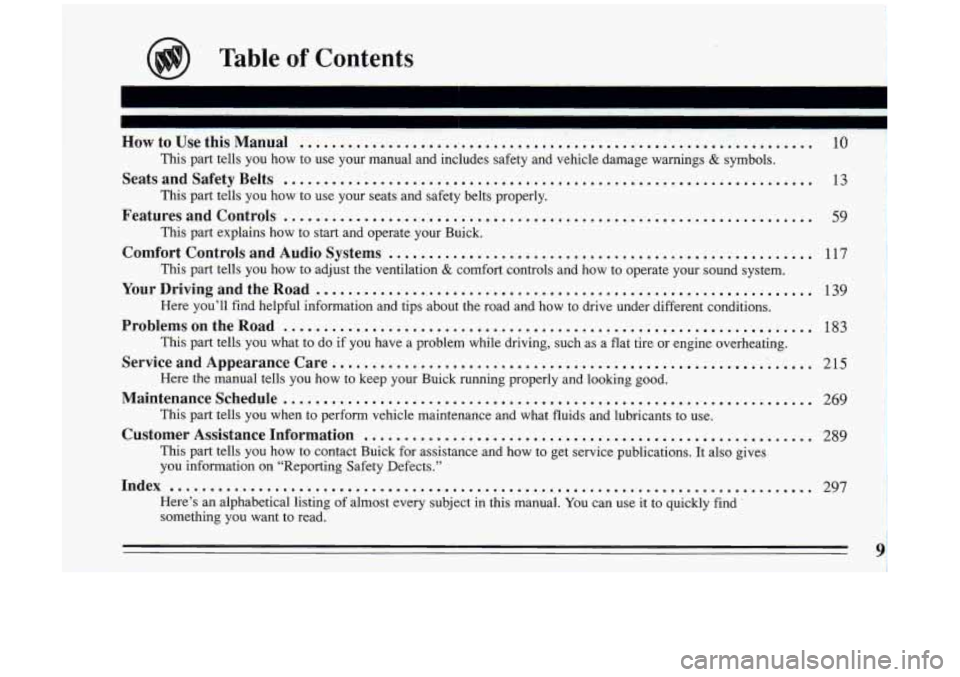
HowtoUsethisManual ................................................................
This part tells you how to use your manual and includes safety and vehicle damage warnings & symbols.
SeatsandSafetyBelts ..................................................................
This part tells you how to use your seats and safety belts properly.
Featuresandcontrols ..................................................................
This part explains how to start and operate your Buick.
This part tells you how to adjust the ventilation
& comfort controls and how to operate your sound system.
YourDrivingandtheRoad ..............................................................
Here you’ll find helpful information and tips about the road and how to drive under different conditions.
ProblemsontheRoad ..................................................................
This part tells you what to do if you have a problem while driving, such as a flat tire or engine overheating.
ServiceandAppearanceCare ............................................................
Here the manual tells you how to keep your Buick running properly and looking good.
Maintenanceschedule ..................................................................
This part tells you when to perform vehicle maintenance and what fluids and lubrica\
nts to use.
Customer Assistance Information ........................................................
This part tells you how to contact Buick for assistance and how to get service publications. It also gives
you information on “Reporting Safety Defects.”
Index ........................................................................\
........
Here’s an alphabetical listing of almost every subject in this manual. You can use it to quickly find
something
you want to read.
Comfort Controls and Audio Systems .....................................................
10
13
59
117
139
183
215
269
289
297
Page 21 of 324
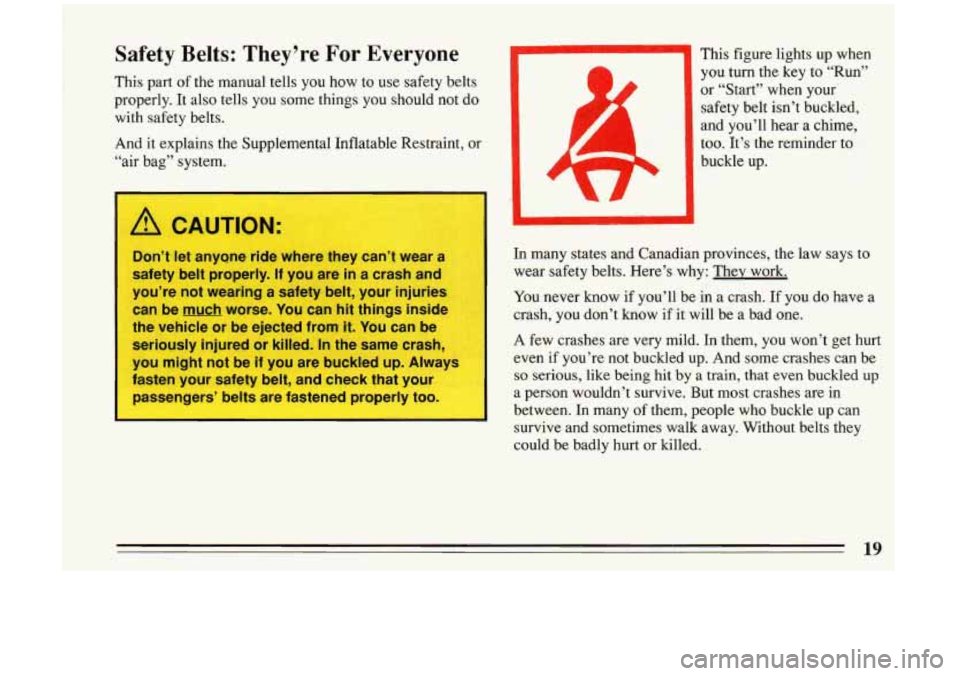
Safety Belts: They’re For Everyone
This part of the manual tells you how to use safety belts
properly. It also tells you some things you should not do
with safety belts.
And
it explains the Supplemental Inflatable Restraint, or
“air bag” system. This figure lights up when
‘you turn the key to “Run”
or “Start” when your’
safety belt isn’t buckled,
.and you’ll hear a chime,
too. It’s the reminder to
buckle up. b’
A CAUTION:
Don’t let anyane ride where they can’t wear i
safety belt properly. If you are in a crash and
you’re not wearing a safety belt, your injuries
can be much worse. You can hit things inside
the vehicle or be ejected from
it. You can be
seriously injured or killed.
In the same crash,
you might not be if you are buckled up. Alwa
fasten your safety belt, and check that your
passengers’ belts are fastened properly too.
In many states and Canadian provinces, the law says to
wear safety belts. Here’s why: They work.
You never know if you’ll be in a crash. If you do have a
crash, you don’t know if
it will be a bad one.
A few crashes are very mild.
In them, you won’t get hurt
even if you’re not buckled up. And some crashes can be
so serious, like being hit by a train, that even buckled up
a person wouldn’t survive. But most crashes are in
between. In many of them, people who buckle up can
survive and sometimes walk away. Without belts they
could be badly hurt
or killed.
19
Page 35 of 324
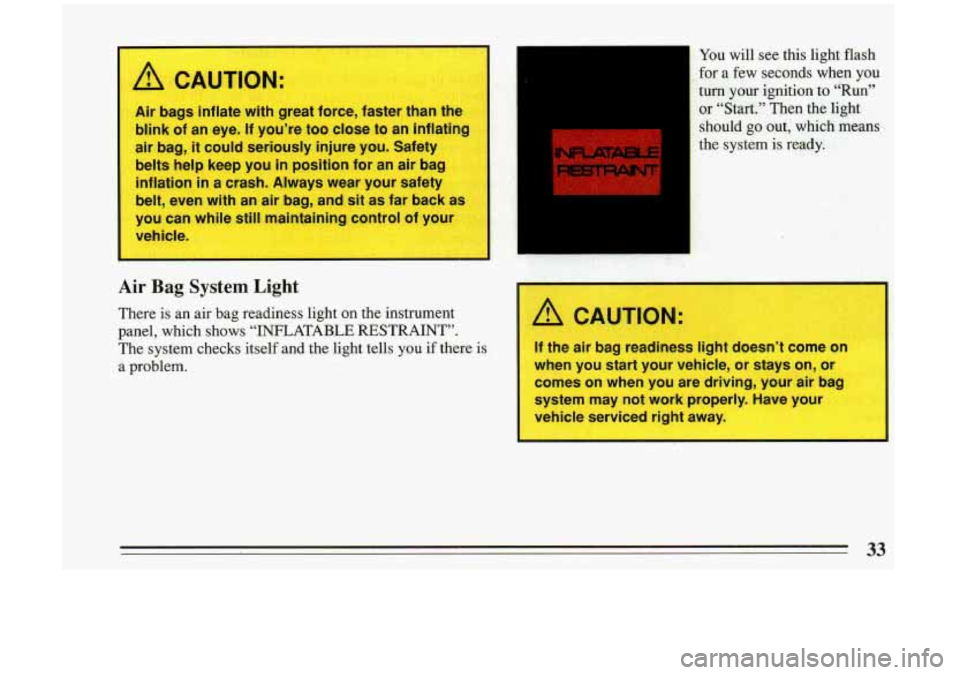
I A CAUTION:
Air bags :..Hate with great force, faster than the
blink of an eye. If you’re too close to an inflating
air bag, it could seriously injure you. Safety
belts help keep you
in position for an air bag
inflation
in a crash. Always wear your safety
belt, even with an air bag, and sit as far back as
you can while
still maintaining control of your
vehicle.
-
Air Bag System Light
There is an air bag readiness light on the instrument
panel, which shows “INFLATABLE RESTRAINT”. You
will see this light flash
for
a few seconds when you
The system checks itself and. $helight
?: tells you if there is
a problem. turn your ignition
to “Run”
or
“Start.” Then the light
should go out, which means
the system
is ready.
A CAUTION:
If the air bag readiness light doesn’t come on
when you start your vehicle, or stays on, or
comes on when you are driving, your air bag
system may not work properly. Have your
vehicle serviced right away.
33
Page 213 of 324
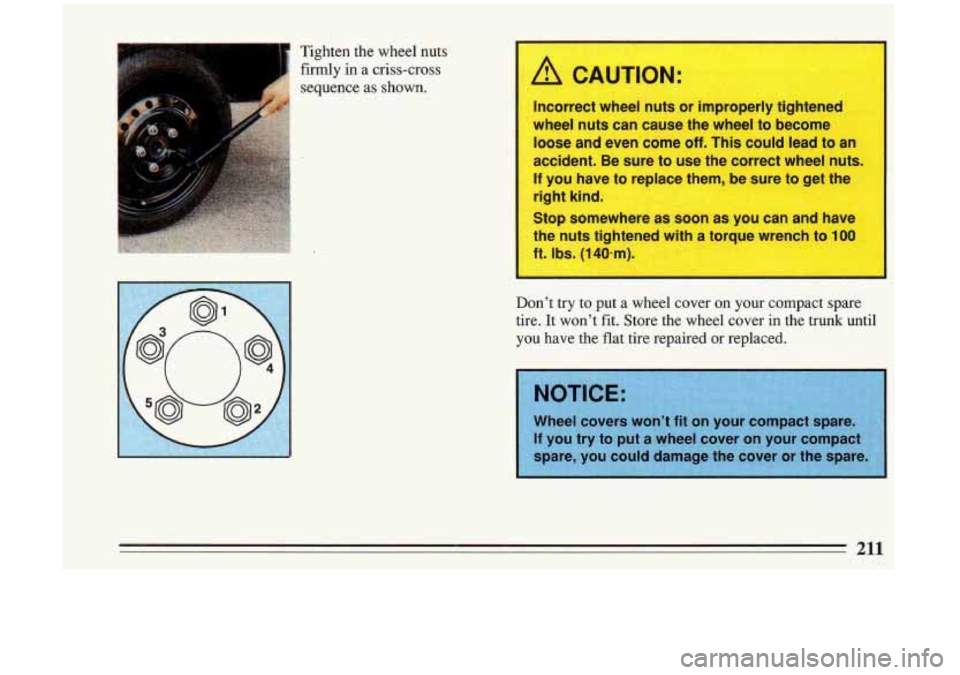
Tighten the wheel nuts
firmly in a criss-cross
sequence as
shown. A CAUTION:
Incorrect wheel nuts or improperly tightened
wheel nuts can cause the wheel to become
loose and even come
off. This could lead to an
accident. Be sure to use the correct wheel nuts.
If you have to replace them, be sure to get the
right kind.
Stop somewhere as soon as you can and have
the nuts tightened with a torque wrench to
100
ft. Ibs. (140.m).
Don't try to put a wheel cover on your compact spare
tire. It won't fit. Store the.whee1 cover
in the trunk until
you have the flat tire repaired
or replaced.
Page 214 of 324
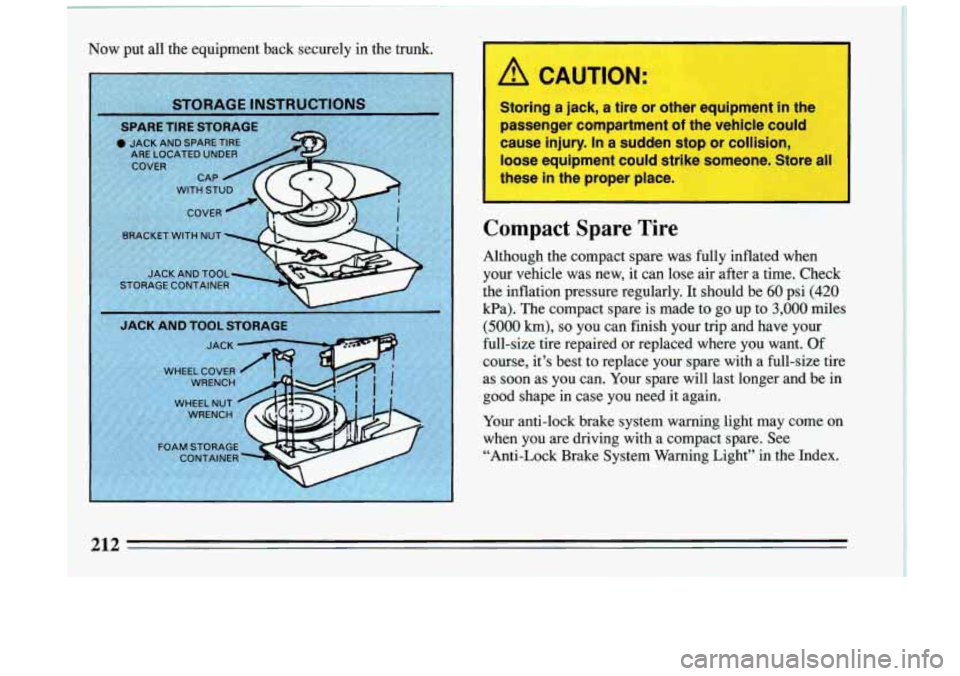
Now put all the equipment back securely in the trunk.
Compact Spare Tire
Although the compact spare was fully inflated when
your vehicle was new, it can lose air after a time. Check
the inflation pressure regularly. It should be
60 psi (420
kPa). The compact spare is made to go up to 3,000 miles
(5000 km), so you can finish your trip and have your
full-size tire repaired or replaced where you want.
Of
course, it’s best to replace your spare with a full-size ti\
re
as soon as you can. Your spare will last longer and be in
good shape in case you need it again.
Your anti-lock brake system warning light may come on
when you are driving with a compact spare. See
“Anti-Lock Brake System Warning Light” in the Index.
212
Page 246 of 324
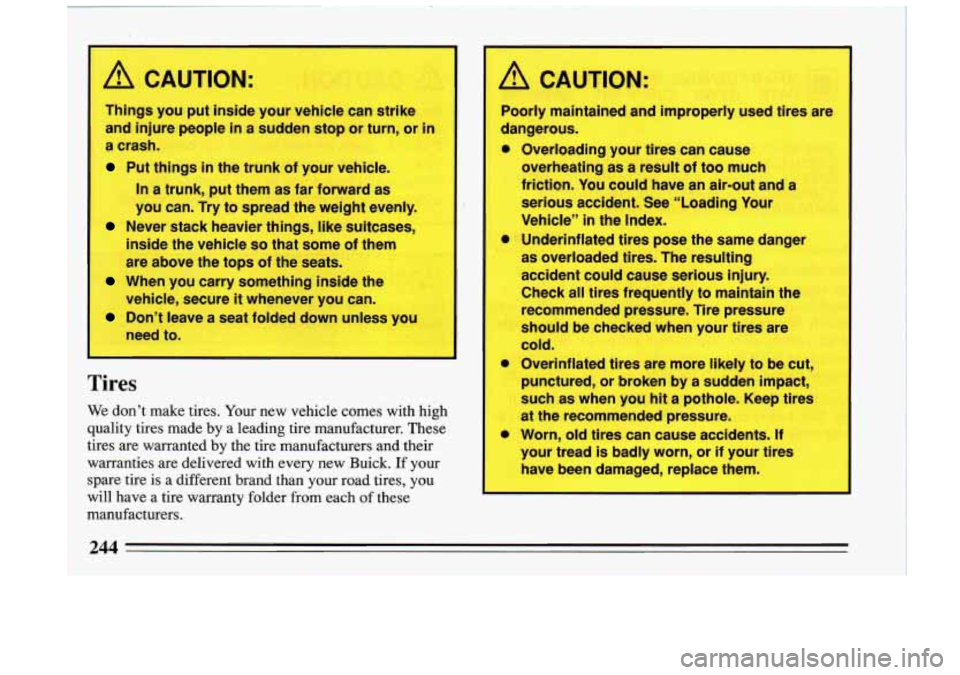
TI
I
A CAUTION:
1 Things you put inside your vehicle can strike
! I
' and injure people in a sudden stop or turn, or in
j a crash.
Put things in the trunk of your vehicle.
In a trunk, put them as far forward as
you can. Try to spread the weight evenly.
Never stack heavier things, like suitcases,
inside the vehicle
so that some of them
are above the tops of the seats.
vehicle, secure it whenever you can.
need to.
When you carry something inside the
Don't leave a seat folded down unless you
Tires
We don't make tires. Your new vehicle comes-with high
quality tires made by a leading tire manufacturer. These
tires are warranted by the tire manufacturers and their warranties are delivered with every new Buick.
If your
spare tire is a different brand than your road tires, you
will have
a tire warranty folder from each of these
manufacturers.
I
A?!,, CAUTION:
1
Poorly maintained and' i!rn,pvaget.ly used tires are
dangemus.
* Owrloadi'ng your tlires can cause
overheatingl
as a result of too much,
friction. You could have an air-crut and a
Vehicle"
in the Index.
Underinflated tires pose tlhe same danger
6s overloaded tires. The viesulting
acci'dent could cause seriouls injury.
Check all1 tires frequently to msintdn the "
recormmended pressure,. Tire (pressure
shoul,d
be checked w'hsn your tires a're
I * averinflated tires are moire likely t'o be ,GU!~,
punctured, 'or broken by a sudden impact,,
such as when you, hit a pothole. Keep tires
at the recommended pres'sura
0 Worn, old tires can cause accidents. If
your tread is ;badily worm,, lor if your tires
have been damaged, replace them
I serious accident. See "kading Your
Gold.
244
Page 304 of 324
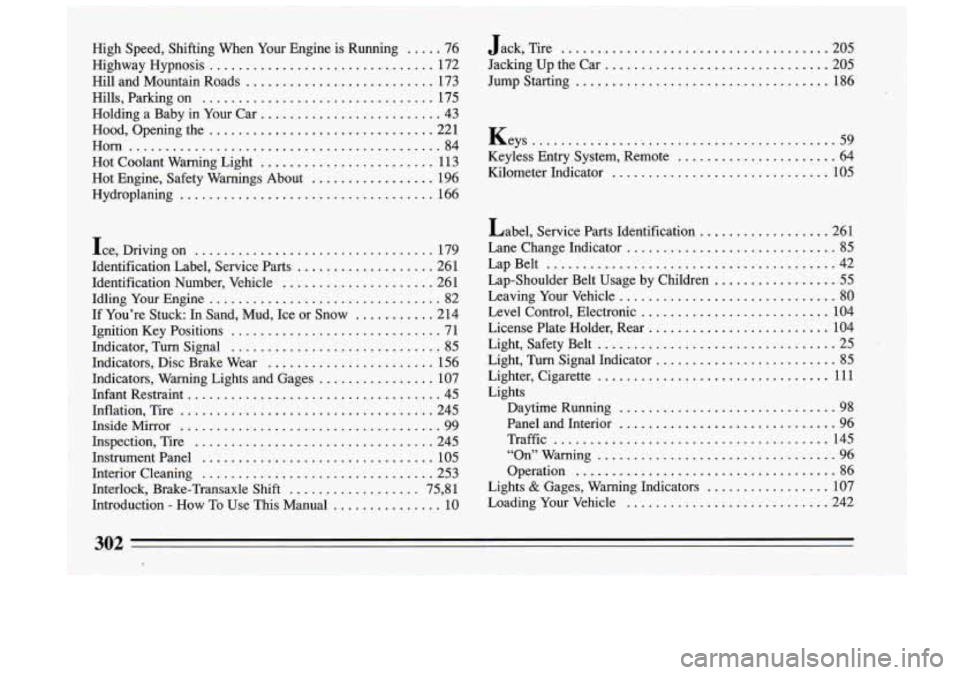
High Speed. Shifting When Your Engine is Running ..... 76 Jack. Tire ..................................... 205
Highway Hypnosis
............................... 172 Jacking Up the Car ............................... 205
Hill and Mountain Roads
.......................... 173 Jump Starting ................................... 186
Hills. Parking on
................................. 175
Holding a Baby in Your Car
......................... 43
Hood. Opening the
............................... 221
Horn ........................................... 84 Keys 59
Hot Coolant Warning Light
........................ 113 Keyless Entry System. Remote 64
Hydroplaning
................................... 166
..........................................
......................
Hot Engine. Safety Warnings About 196 Kilomefa- J&$q$cx .. +... .? . ... _. % ......... . ... .’_ rs.z7 t- ........ . 105 .................
Ice. Driving on ................................. 179
Identification Label. Service Parts
................... 261
Identification Number. Vehicle
..................... 261
Idling Your Engine
................................ 82
If You’re Stuck: In Sand. Mud. Ice or Snow
........... 214
Indicator. Turn Signal
............................. 85
Indicators. Disc Brake Wear ....................... 156
Indicators. Warning Lights and Gages
................ 107
Infant Restraint
................................... 45
Inflation. Tire
................................... 245
Inside Mirror
.................................... 99
Inspection. Tire
................................. 245
Instrument Panel
................................ 105
Interior Cleaning
................................ 253
Interlock. Brake-Transaxle Shift
.................. 75. 81
Introduction
. How To Use This Manual ............... 10
Ignition Key Positions
............................. 71
Label.
Service Parts Identification
.................. 261
Lane Change Indicator
............................. 85
Lap-Shoulder Belt Usage by Children
................. 55
Leaving Your Vehicle .............................. 80
Level Control. Electronic
.......................... 104
License Plate Holder. Rear
......................... 104
Light. Safety Belt
................................. -25
Light.
Turn Signal Indicator ......................... 85
Lighter. Cigarette
................................ 111
Lights Daytime Running
.............................. 98
Panel and Interior
.............................. 96
Traffic
...................................... 145
“On” Warning
................................. 96
Operation
.................................... 86
Loading Your Vehicle ............................ 242
Lap Belt
........................................ -42
Lights
& Gages. Warning Indicators ................. 107
302